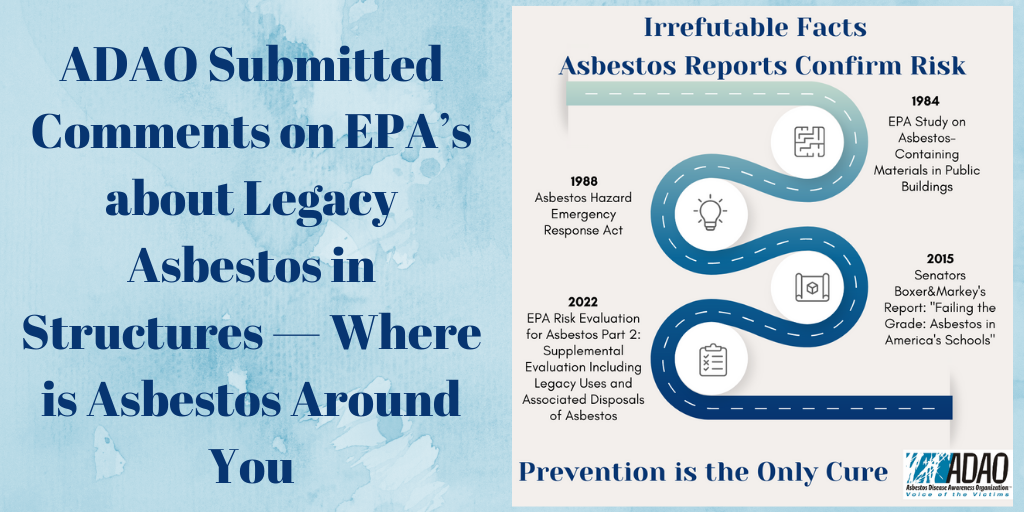Posted on March 1, 2022
Today, the Asbestos Disease Awareness Organization (ADAO) submitted public comments on the Environmental Protection Agency’s (EPA) Part 2 Risk Evaluation for Asbestos. EPA’s Part 2 evaluation resulted from a lawsuit filed by ADAO, other public health organizations, and leading scientists. The parties involved agreed to settle this case with a consent decree that establishes an enforceable deadline of December 1, 2024 for EPA to complete the evaluation.
The Part 2 risk evaluation will examine the threat of ongoing use and disposal of the “legacy” asbestos which remains embedded in buildings, infrastructure and products across the United States.
ADAO filed our lawsuit because the Agency’s Part 1 Chrysotile Asbestos Risk Evaluation was riddled with dangerous gaps and omissions. Most importantly, it excluded legacy uses and associated disposals, addresses the threat of ongoing use and disposal of the “legacy” asbestos which remains embedded in buildings, infrastructure and products across the United States.
After reviewing the comments, EPA will issue a final scoping document. It was a top priority for ADAO and partners to submit the best information and advice to EPA during this period. Bob Sussman, ADAO counsel, added, “If EPA carries out the commitments they agreed to in these settlements, it will help ensure that the Part 2 evaluation is comprehensive under TSCA, addresses all hazards and pathways of exposure, and is completed without further delay.” This evaluation will determine whether current modes of handling, maintaining, repairing and disposing of legacy asbestos in buildings, factories, products, and articles present an unreasonable risk of injury to human health and the environment.
In our public comments, we state that, consistent with the ADAO-EPA settlement agreement, the Part 2 evaluation will include several key components lacking in Part 1:
- The scoping document properly adopts the AHERA definition of asbestos.
- EPA has properly included Libby Amphibole asbestos in the scope of the Part 2 evaluation.
- While Part 1 was limited to chrysotile asbestos, Part 2 will properly address all six recognized asbestos fibers.
- And more.
However, the draft scoping document does not recognize the impact of the upcoming asbestos TSCA Section 8(a) reporting and record keeping rule on the Part 2 evaluation. EPA is required to promulgate this rule under a settlement agreement with ADAO. The final scoping document should clarify how EPA will use the reports it receives under the rule in conducting Part 2.
EPA should recognize that:
- The continued presence of asbestos building materials in homes, schools, apartments, public buildings, offices, stores, factories, and abandoned buildings is a major ongoing source of exposure and risk.
- Asbestos is also contained in public infrastructure, including water distribution systems, pipelines and electric power generation and transmission facilities.
- Release of asbestos fibers when asbestos-containing material (“ACM”) is disturbed or damaged — including due to construction projects, public infrastructure, fires, extreme weather events, and other disasters — contributes to elevated exposure and health risk.
- Asbestos risks to teachers, students, and staff in schools and colleges are widespread and significant.
If EPA determines that the current use and handling of legacy asbestos presents an unreasonable risk, TSCA requires the Agency to impose requirements that manage or eliminate the risk. These requirements could be critical in reducing asbestos-related death and disease from legacy asbestos exposure. The last time EPA did a legacy study was nearly 40 years ago, in 1984. That study found one-fifth of all public and commercial buildings had asbestos-containing materials. Now, we finally have the chance to go back and correct the decades-long man-made disaster that is legacy asbestos.
Legacy asbestos is an old conversation as seen in:
- 1984 — EPA Study on Asbestos-Containing Materials in Public Buildings
- 1988 — Asbestos Hazard Emergency Response Act
- 2015 — Senators Boxer & Markey’s Report: ” Failing the Grade: Asbestos in America’s Schools” Report
- 2022 — EPA Risk Evaluation for Asbestos Part 2: Supplemental Evaluation Including Legacy Uses and Associated Disposals of Asbestos
Over 40,000 Americans die annually as a result of asbestos-caused diseases. Scientists and public health experts universally agree that there is no safe level of use or exposure to asbestos. While legacy asbestos is now subject to many federal, state and local laws that govern exposure in the workplace and schools, to protect construction and maintenance workers, teachers, and the general public from unsafe conditions, a 2015 study conducted by Senators Boxer and Markey, the report found that “the States do not appear to be systematically monitoring, investigating or addressing asbestos hazards in schools [nor do they] report conducting regular inspections of local education agencies to detect asbestos hazards and enforce compliance.” This is, quite simply, unacceptable.
The EPA Risk Evaluation must take these regulations into account and review their effectiveness in preventing asbestos-related deaths and disease.
While EPA advances the Part 2 Risk Evaluation and Management, we continue to work with Congress on legislation to ban asbestos imports and use. Our lives depend on it.
Linda Reinstein
